Click on image to see larger version
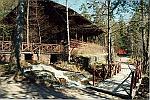 |
Laginkoski
(Lagin Rapids) Imperial Fishing Lodge. Czar Alexander III, Emporer
of Russia, Grand Duke of Finland, had visited the Langin Rapids
area at Kotka, because he had heard about the good salmon fishing
in the rapids. The Finnish architects Magnus Schjerfbeck, Sebastian
Gripenberg and Jac. Ahrenberg designed a simple villa for Emperor
Alexander and his Danish born empress Dagmar (Maria Feodorovna). |
 |
In 1880
Czar Alexander visited these rapids to watch the fishing on the
Kymi river. He also did some hiking to look at the beautiful scenery.
On his next visit to this area, he said that he wished to have a
fishing lodge built on the banks of the river. |
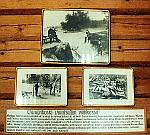 |
Pictures
inside the Imperial Fishing Lodge of fishing in Langinkoski . In
the autumn of 1896 a salmon weighin 78 pouns (34.6 kilos) was caught
at Laginkoski. It still ranks among the biggest ever caught in Finland. |
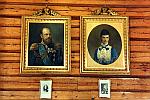 |
Alexander
III and Marie Feodorovna painted by the Russian artist Nikolai Schilder.
In October 1866 Alexander married the Danish Princess Dagmar (1847-1928).
After her conversion to Orthodoxy, she took the name of Marie Fedorovna.
Together, Alexander III and Empress Dagmar had five children. Their
first child, Nicholas, was born in 1868 and would be the last Tsar
of Russia. Their second child, George, was born in 1871 followed
by Xenia (1871), Michael (1878) and Olga (1882). George died at
27 of tuberculosis in 1899. Empress Dagmar lived a widow for 32
years. She died in 1928 in her native country Denmark. She never
returned to Langinkoski after the death of her husband. |
 |
At the
wish of the imperial owners the interior decorating was made very
simple!! The front of the main living room area of the lodge, with
original furnishings.The house-warming on the 15th of July 1889
was a family affair. The newspapers reported to their readers about
the uncomplicated way of life of the imperial family, with the empress
doing the cooking and the emperor carrying firewood and water. |
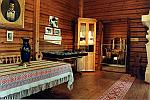 |
Another
view of the large living room. At Langinkoski, the Czar's family
relaxed, the emporer fished in the rapids in front of the lodge,
and took his children for walks in the forest. |
 |
Another
view of the living room, the large fire place, looking out of the
room towards the entrance way to the lodge. Czar Alexander III visited
Langinkoski about 10 times, traveling from St. Petersburg by ship.
The well-sheltered bay at the outlet of the Kymi River. Born in
St Petersburg on February 26, 1845, Czar Alexander III died in 1894.
|
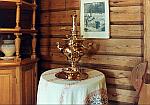 |
A copper
coffee urn, some of what were called the simple furnishings in the
lodge. Czar Nicholas II, the last emporer of Russia, was not particularly
interested in Laginkoski. He and his family visited the lodge once
on the 5th of September 1906. |
 |
A view
of the kitchen in the lodge. During World War I the lodge served
as a rest home for wounded Russian Soldiers. When Finland became
an independent state in 1917, the imperial lodge was taken over
by the Finnish government. |
 |
Another
view of the kitchen of the lodge. The area surrounding the imperial
fishing lodge was declared a national park in 1960. On the 100th
anniversary of the fishing lodge in July 1989, Captain Tihon Kulikovsky,
grandson of emporer Alexander II and Empress Dagmar, and his wife,
from Canada, visited the lodge as guests of honor. |
 |
A room
adjacent to the living room that was used by Empress Dagmar. |
 |
The Romanov
flag. |
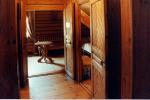 |
The upstairs
bedroom of the body guards of the royal family. |
 |
Furnishings
in the bedroom of the escorts of the royal family. |
 |
The bedroom used by the Emporer and Empress. |
 |
Another bedroom used by the royal family. |
